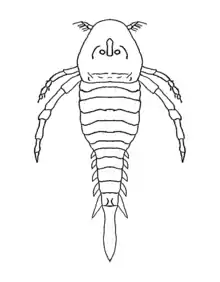Hallipterus
Hallipterus is a genus of prehistoric eurypterid classified as part of the family Hardieopteridae.[1]
| Hallipterus Temporal range: Devonian, | |
|---|---|
_(20617594530).jpg.webp) | |
| Carapace of H. excelsior | |
| Scientific classification | |
| Domain: | Eukaryota |
| Kingdom: | Animalia |
| Phylum: | Arthropoda |
| Subphylum: | Chelicerata |
| Order: | †Eurypterida |
| Superfamily: | †Kokomopteroidea |
| Family: | †Hardieopteridae |
| Genus: | †Hallipterus Kjellesvig-Waering, 1963 |
| Type species | |
| †Hallipterus excelsior Hall, 1884 | |
| Synonyms | |
| |
Description

Hallipterus was a gigantic Hardieopterid eurypterid. Though some previous estimates have placed its size at over 1.5 meters in length, these were likely excessive.[1] Still, assigned specimens suggest a size of over 1 meter long.[1]
The carapace was subelliptical, greater in length than in width, with a prominent and unornamented marginal rim. The eyes were very small, close to each other and separated by a prominent median ridge with large ocelli at the posterior extremity.[2]
The chelicerae were simple and elongated. The first walking legs possessed flat and movable spines. The rest of the legs and the opisthosoma remain unknown.[2]
Species
Hallipterus contains one valid species, H. excelsior, from the Devonian of New York.[3] Another species was once recognized from similarly aged deposits in Pennsylvania, "H. lacoanus",[2] but it is today seen as synonymous with H. excelsior.[1]
See also
References
- Tetlie, O. E. (2008). "Hallipterus excelsior, a Stylonurid (Chelicerata: Eurypterida) from the Late Devonian Catskill Delta Complex, and Its Phylogenetic Position in the Hardieopteridae". Bulletin of the Peabody Museum of Natural History. 49: 19–99. doi:10.3374/0079-032X(2008)49[19:HEASCE]2.0.CO;2.
- "Page:A Revision of the Families and Genera of the Stylonuracea (Eurypterida).djvu/28 - Wikisource, the free online library". en.wikisource.org. Retrieved 2017-12-28.
- Dunlop, J. A., Penney, D. & Jekel, D. 2015. A summary list of fossil spiders and their relatives. In World Spider Catalog. Natural History Museum Bern, online at http://wsc.nmbe.ch , version 16.0 http://www.wsc.nmbe.ch/resources/fossils/Fossils16.0.pdf (PDF).
